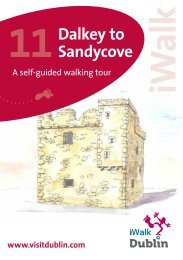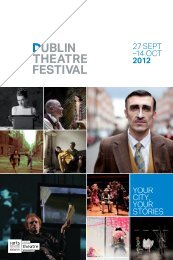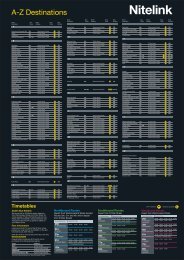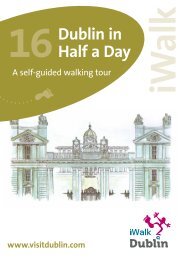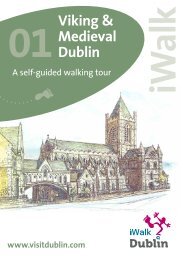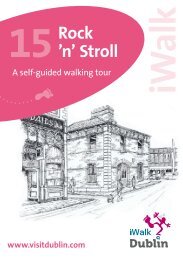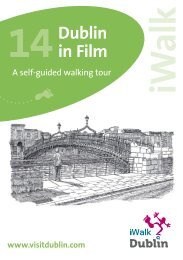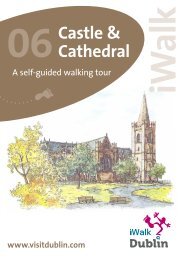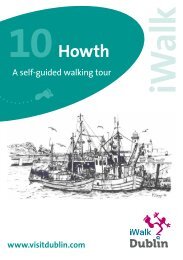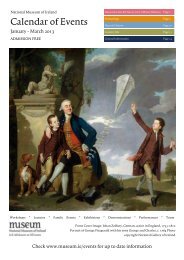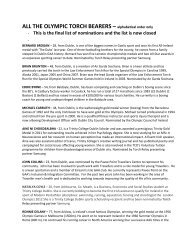iWalk 07 In the Steps of Ulysses - A self-guided ... - Visit Dublin
iWalk 07 In the Steps of Ulysses - A self-guided ... - Visit Dublin
iWalk 07 In the Steps of Ulysses - A self-guided ... - Visit Dublin
Create successful ePaper yourself
Turn your PDF publications into a flip-book with our unique Google optimized e-Paper software.
<strong>07</strong><br />
<strong>In</strong> <strong>the</strong> <strong>Steps</strong><br />
<strong>of</strong> <strong>Ulysses</strong><br />
A <strong>self</strong>-<strong>guided</strong> walking tour<br />
<strong>iWalk</strong><br />
www.visitdublin.com
Welcome<br />
to <strong>Dublin</strong><br />
We hope that as you take time to walk<br />
around and explore <strong>Dublin</strong> you will discover<br />
<strong>the</strong> Irish capital is at <strong>the</strong> very heart <strong>of</strong> Irish<br />
culture and <strong>of</strong>fers endless choices to our<br />
visitors. <strong>Dublin</strong>’s real appeal is her people,<br />
so don’t be afraid to stop and ask for<br />
directions along your walk – <strong>Dublin</strong>ers’<br />
hospitality and wit will captivate you!<br />
www.visitdublin.com/iwalks<br />
North Earl Street 4<br />
No. 5 Parnell Square 4<br />
Top <strong>of</strong> Parnell Square East 4<br />
Eccles Street 5<br />
St George’s Church 5<br />
Belvedere College 5<br />
North Great George’s Street 6<br />
James Joyce Street 6<br />
George’s Quay, Opposite<br />
to <strong>the</strong> Custom House 6<br />
The Sean O’Casey Bridge 7<br />
Corner <strong>of</strong> Westland Row<br />
and Pearse Street 7<br />
Under <strong>the</strong> Railway Bridge 8<br />
<strong>In</strong>side St Andrew’s Church 8<br />
Sweny’s Chemist 9<br />
Leinster Street South 9<br />
Davy Byrne’s Pub 9<br />
Route Map 10
4<br />
Stop 1: North Earl Street<br />
The tour commences from <strong>the</strong> James Joyce Statue on North Earl<br />
Street, just <strong>of</strong>f O’Connell Street beside <strong>the</strong> Spire. Leopold Bloom’s<br />
actual journey started from Eccles Street but on our fairly direct way<br />
up to <strong>the</strong>re you will pass some places associated with Joyce and<br />
‘<strong>Ulysses</strong>’. If you want to go directly to Eccles Street you may pick up<br />
a number 16 or 16A bus from O’Connell Street which will leave you<br />
close to <strong>the</strong> intersection <strong>of</strong> Eccles Street and Dorset Street. Ask <strong>the</strong><br />
bus driver where to let you <strong>of</strong>f. If you take <strong>the</strong> bus to Eccles Street<br />
your tour will start from Stop No. 4.<br />
Stop 2: No. 5 Parnell Square<br />
Recommence walking up O’Connell Street heading towards <strong>the</strong><br />
Parnell Monument which commemorates one <strong>of</strong> Ireland’s great<br />
19th century statesmen. Behind this monument and over to<br />
<strong>the</strong> left is <strong>the</strong> classical edifice <strong>of</strong> <strong>the</strong> Rotunda Hospital, believed<br />
to be <strong>the</strong> world’s first purpose-built maternity hospital. Cross<br />
over Parnell Street and up Cavendish Row which continues into<br />
Parnell Square, passing, on your left, <strong>the</strong> famous Gate Theatre<br />
which was founded in 1928 in <strong>the</strong> former Grand Supper Room<br />
<strong>of</strong> <strong>the</strong> Rotunda Hospital’s Assembly Rooms, originally built in<br />
1786. Stop opposite number 5 Parnell Square.<br />
Stop 3: Top <strong>of</strong> Parnell<br />
Square East<br />
Walk a short distance up to <strong>the</strong> top <strong>of</strong> <strong>the</strong> square and<br />
pause for a few moments to look across at <strong>the</strong> Garden<br />
<strong>of</strong> Remembrance and beyond it across to Parnell Square<br />
West. Tucked in between <strong>the</strong> Abbey Presbyterian<br />
Church and <strong>the</strong> <strong>Dublin</strong> City Gallery, <strong>the</strong> Hugh Lane,<br />
is <strong>the</strong> renowned Writer’s Museum.
Stop 4: Eccles Street<br />
Without fur<strong>the</strong>r ado, you will make your way straight to<br />
<strong>the</strong> next stop and <strong>the</strong> real starting point <strong>of</strong> this tour. Walk<br />
straight up past <strong>the</strong> junction with Great Denmark Street,<br />
continue along Frederick Street North and turn right<br />
into Dorset Street Lower. Cross <strong>the</strong> road when you safely<br />
can do so, continuing for 200 metres until you come to<br />
Eccles Street and turn left. Cross over to <strong>the</strong> Mater Private<br />
Hospital and stand in front <strong>of</strong> <strong>the</strong> plaque to <strong>the</strong> right <strong>of</strong><br />
<strong>the</strong> main door. This plaque has <strong>the</strong> head <strong>of</strong> James Joyce<br />
sculptured onto it. This part <strong>of</strong> <strong>the</strong> journey should, on<br />
average, take about 10 to 15 minutes.<br />
5<br />
Stop 5: St George’s Church<br />
Walking down Eccles Street to <strong>the</strong> corner with Dorset Street<br />
you can mirror Bloom’s journey. Before you cross over Dorset<br />
Street make a short side trip to follow Bloom as he travels to<br />
<strong>the</strong> butcher. He turned <strong>the</strong> corner at what is still a pub, but<br />
<strong>the</strong>n called Larry O’Rourke’s, and turned right to walk down<br />
Dorset Street, passing over <strong>the</strong> pub’s grating (now a steel<br />
trapdoor) from which floated up <strong>the</strong> flabby gush <strong>of</strong> porter.<br />
On <strong>the</strong> right he passed <strong>the</strong> former St Joseph’s National School,<br />
a dark red-bricked building with five bay windows. Finally<br />
Bloom reaches a butcher’s window where he sees <strong>the</strong> last<br />
kidney for sale, a pork kidney which oozed blood. (You won’t<br />
find this shop as it never existed, one <strong>of</strong> <strong>the</strong> few fictitious<br />
places Joyce refers to.) Now turn around and come back to <strong>the</strong><br />
corner again.<br />
Let Bloom return home to give Molly her breakfast and have his own precious kidney, nearly burning<br />
it in <strong>the</strong> process. The postman delivers a letter addressed to Molly from her lover, Blazes Boylan, and<br />
Leopold leaves to travel to town to see if <strong>the</strong>re is a letter for him at Westland Row Post Office from<br />
Martha, a girl he’s never met but with whom he shares a romantic correspondence. Now cross over<br />
<strong>the</strong> road and head directly along Hardwicke Place to <strong>the</strong> elegantly-spired church ahead.<br />
Stop 6: Belvedere College<br />
Walk down Temple Street and <strong>the</strong>n turn right into<br />
Great Denmark Street. Stop in front <strong>of</strong> a mansion-like<br />
building which stands opposite to North Great George’s Street.<br />
This is Belvedere College.
6<br />
Stop 7: North Great George’s Street<br />
Cross <strong>the</strong> road and walk down on <strong>the</strong> left side <strong>of</strong> North Great George’s Street<br />
until you reach no No. 35.<br />
Stop 8: James Joyce Street<br />
You are still on a parallel but different route to Leopold Bloom but you will soon converge<br />
on his original path. Proceed down to <strong>the</strong> bottom <strong>of</strong> North Great George’s Street, turn<br />
left onto Parnell Street, cross Gardiner Street at <strong>the</strong> next junction and cross again to walk<br />
down Gardiner Street on <strong>the</strong> left-hand side. You have now regained Bloom’s itinerary. You<br />
can see what he saw and apart from some new apartment blocks <strong>the</strong> overall view is little<br />
changed since 1904. The railway bridge still crosses <strong>the</strong> street obscuring <strong>the</strong> aspect to <strong>the</strong><br />
magnificent Custom House. Take <strong>the</strong> second left into Railway Street and right again into<br />
James Joyce Street. Stop at <strong>the</strong> junction with Foley Street.<br />
Stop 9: George’s Quay, Opposite<br />
to <strong>the</strong> Custom House<br />
Exit James Joyce Street, turn right up Talbot Street and left again to<br />
regain Gardiner Street. With <strong>the</strong> help <strong>of</strong> pedestrian lights cross over a<br />
series <strong>of</strong> junctions to gain <strong>the</strong> left-hand side <strong>of</strong> Beresford Place and walk<br />
along by <strong>the</strong> boundary wall <strong>of</strong> <strong>the</strong> Custom House. Cross over <strong>the</strong> River<br />
Liffey by way <strong>of</strong> Butt Bridge and turn left along by <strong>the</strong> river until you<br />
reach opposite <strong>the</strong> classical pile <strong>of</strong> <strong>the</strong> Custom House.
7<br />
Stop 10: The Sean O’Casey Bridge<br />
<strong>In</strong>stead <strong>of</strong> going <strong>the</strong> direct route his journey meanders quite a bit, reflecting <strong>the</strong> confusions<br />
within his own mind. Proceed down George’s Quay, go over <strong>the</strong> next bridge, <strong>the</strong> Matt<br />
Talbot Bridge, and onto <strong>the</strong> campshire along City Quay. A campshire is <strong>the</strong> walking area<br />
along by <strong>the</strong> riverfront where once <strong>the</strong> cranes hauled <strong>the</strong> goods from <strong>the</strong> holds <strong>of</strong> ships.<br />
The ships are long gone to fur<strong>the</strong>r downriver and <strong>the</strong> Campshires have been beautifully<br />
upgraded. We presume Bloom walked along <strong>the</strong> opposite pavement but he certainly would<br />
have chosen <strong>the</strong> campshire had he <strong>the</strong> choice. All <strong>the</strong> places that he passed on this section<br />
<strong>of</strong> <strong>the</strong> journey are long gone including Leask’s <strong>the</strong> linseed crusher’s, <strong>the</strong> postal telegraph<br />
<strong>of</strong>fice and <strong>the</strong> Sailors’ Home.<br />
The morning noises on<br />
<strong>the</strong> quayside Bloom heard<br />
were <strong>the</strong> sounds <strong>of</strong> a busy<br />
dockland, now also long gone,<br />
replaced by container traffic<br />
at a different location. When<br />
you come to <strong>the</strong> modern<br />
pedestrian bridge stop here<br />
for a while, even walk onto<br />
<strong>the</strong> bridge to take in <strong>the</strong> view.<br />
Stop 11:<br />
Corner <strong>of</strong> Westland Row and Pearse Street<br />
Bloom’s rambles next took him into Lime Street. Nothing remains in this district from 1904<br />
so we will take a short cut to catch up with Bloom again. Cross over from <strong>the</strong> bridge and stroll<br />
up Lombard Street on <strong>the</strong> right-hand side. You will meet with Bloom after <strong>the</strong> junction with<br />
Townsend Street. The frowning face <strong>of</strong> Be<strong>the</strong>l which was <strong>the</strong> Salvation Army Hostel, was at Nos.<br />
19/20. The face no longer frowns as it has been replaced by a more modern reincarnation. Next<br />
pass Nichols’ <strong>the</strong> undertakers at Nos. 26-31: not only is <strong>the</strong> building still <strong>the</strong>re but so is Nichols’<br />
it<strong>self</strong>, and probably not much changed since Bloom’s shadow fell on it. Bloom <strong>the</strong>n went across<br />
Great Brunswick Street – to you that is now called Pearse Street. Stand at <strong>the</strong> corner with Pearse<br />
Street and Westland Row.
8<br />
Stop 12: Under <strong>the</strong> Railway Bridge<br />
Once he collected <strong>the</strong> letter from his lady friend by correspondence, Bloom put it<br />
in his pocket and decided to pick a quiet place to read its contents. After his bad luck<br />
in bumping into an acquaintance by <strong>the</strong> name <strong>of</strong> McCoy, he strolled back to Great<br />
Brunswick Street modern day Pearse Street and turned right along <strong>the</strong> high station<br />
wall. You may follow him by crossing Westland Row and proceeding down Pearse<br />
Street. <strong>In</strong> Bloom’s day <strong>the</strong>re was a vehicle ramp which led up to <strong>the</strong> station’s platforms<br />
but it was demolished to make way for Goldsmith Hall, a lecture hall and residence<br />
facility for Trinity College. There is no hackney or carriage rank here any more so you<br />
won’t experience <strong>the</strong> sweet oaten reek <strong>of</strong> horsepiss that Bloom noticed as he passed<br />
<strong>the</strong> parked horses. Turn into Cumberland Street and stand under <strong>the</strong> bridge where<br />
Bloom stopped to read his letter surreptitiously.<br />
Stop 13: <strong>In</strong>side St Andrew’s Church<br />
Bloom <strong>the</strong>n went in through <strong>the</strong> backdoor <strong>of</strong> <strong>the</strong> church which he called All Hallows but is <strong>of</strong>ficially<br />
known as St Andrews Roman Catholic Church. The backdoor is no longer open so you will open <strong>the</strong><br />
gate which is usually unlocked during <strong>the</strong> daytime and go along <strong>the</strong> side passage until you reach <strong>the</strong><br />
front <strong>of</strong> <strong>the</strong> church. If <strong>the</strong> church is closed <strong>the</strong>n <strong>the</strong> gate will also be locked. <strong>In</strong> such a case walk around<br />
to Westland Row by <strong>the</strong> way you came here in <strong>the</strong> first place. Enter <strong>the</strong> interior and savour what Joyce<br />
describes as <strong>the</strong> cold smell <strong>of</strong> sacred stone.
Stop 15: Leinster Street South<br />
Proceed along Lincoln Place towards Leinster Street South in <strong>the</strong> manner <strong>of</strong> Bloom who went<br />
cheerfully towards <strong>the</strong> mosque <strong>of</strong> <strong>the</strong> baths redbaked bricks, <strong>the</strong> minarets. This description<br />
accurately fits <strong>the</strong> Turkish Bath Company <strong>of</strong> 6-15 Lincoln Place, but this building was not in use<br />
by 1904, so probably his destination was <strong>the</strong> Turkish and Warm Baths <strong>of</strong> 10 to 11 Leinster Street<br />
South now just a dark-bricked and soulless-looking <strong>of</strong>fice block. He notes, as you can, <strong>the</strong> gates<br />
<strong>of</strong> College Park which is a side entrance into Trinity College. Stop opposite to <strong>the</strong> where <strong>the</strong><br />
railings <strong>of</strong> Trinity College begin.<br />
Stop 16: Davy Byrne’s Pub<br />
This is where we will leave Joyce and Bloom for<br />
now. Bloom, after his Turkish bath, takes a tram<br />
to Sandymount, accompanies Dignam’s funeral to<br />
Glasnevin Cemetery and on his return to town visits<br />
his place <strong>of</strong> employment, <strong>the</strong> Freeman’s Journal. He<br />
decides he needs to get a copy <strong>of</strong> an advertisement<br />
from <strong>the</strong> Kilkenny People and makes his way to<br />
consult it in <strong>the</strong> National Library. He journeys past<br />
Trinity College, up Grafton Street and into Duke<br />
Street and pops into Davy Byrne’s Pub for lunch.<br />
This is where you are now headed for. After his lunch<br />
Bloom visits <strong>the</strong> National Library, wanders up towards<br />
Temple Bar and makes for <strong>the</strong> Ormond Hotel on<br />
Ormond Quay. All <strong>of</strong> this and more will have to wait<br />
for ano<strong>the</strong>r day. For now walk along Leinster Street<br />
South and continue where it becomes Nassau Street<br />
and turn left into Dawson Street, taking <strong>the</strong> first turn<br />
to <strong>the</strong> right which is Duke Street. A little more than<br />
halfway down on <strong>the</strong> left is Davy Byrnes.<br />
Stop 14: Sweny’s<br />
Chemist<br />
9<br />
When you are ready to leave <strong>the</strong><br />
prayerful atmosphere <strong>of</strong> St Andrews,<br />
walk up Westland Row. Pause opposite<br />
number 21, a house on <strong>the</strong> right-hand<br />
side with a plaque on <strong>the</strong> wall. This<br />
was <strong>the</strong> birthplace in 1854 <strong>of</strong> ano<strong>the</strong>r<br />
<strong>of</strong> <strong>Dublin</strong>’s famous writers and wits,<br />
Oscar Wilde. When you reach <strong>the</strong> top <strong>of</strong><br />
<strong>the</strong> street observe a chemist’s shop or<br />
pharmacy which stands directly facing<br />
you. This is Sweny’s Chemist.
CRANE LANE<br />
10<br />
Eccles Street<br />
<strong>iWalk</strong><br />
route map<br />
GRANGE GORMAN<br />
BRUNSWICK STREET NORTH<br />
CHURCH STREET<br />
CONSTITUTION HILL<br />
North Great<br />
George’s Street<br />
No. 5 Parnell Square<br />
James Joyce Street<br />
Belvedere College<br />
Top <strong>of</strong><br />
Parnell Square East<br />
St George’s Church<br />
KING’SS INN ST.<br />
DOMINICK LANE<br />
BOLTON STREET DORSET STREET<br />
LOFTUS LANE<br />
GRANBY LANE<br />
DOMINICK PLACE<br />
DOMINICK STREET<br />
03<br />
PARNELL STREET<br />
FRED<br />
PARNEL<br />
PARNE<br />
KING STREET NORTH<br />
North Earl Street<br />
QUEEN STREET<br />
SMITHFIELD<br />
BOW STREET<br />
George’s Quay<br />
JERVIS LANE<br />
CAPEL STREET<br />
WOLFE TONE STREET<br />
MARY STREET<br />
JERVIS STREET<br />
ABBEY STREET UPPER<br />
PHOENIX ST. HAMMOND<br />
ARRAN QUAY<br />
The Sean O’Casey Bridge<br />
CHURCH STREET<br />
STRAND STREET GREAT<br />
ORMOND QUAY LOWE<br />
MILLENIUM<br />
BRIDGE<br />
PARLIAMENT STREET<br />
THOMAS STREET<br />
HANBURY LANE<br />
EARL ST. SOUTH<br />
PIMLICO<br />
MEATH<br />
USHERS QUAY<br />
OLIVER BOND COOK STREET<br />
MEATH STREET<br />
WEST<br />
SWIFT’S ALLEY<br />
ASH STREET<br />
BRIDGE ST.<br />
CORN MARKET<br />
THOMAS DAVIS<br />
FRANCIS STREET<br />
INNS QUAY<br />
Under <strong>the</strong> Railway Bridge<br />
MERCHANTS QUAY<br />
HIGH STREET<br />
RACK LANE<br />
DILLON ST.<br />
HANNOVER<br />
ICK STREET<br />
WINE TAVERN STREET<br />
Corner <strong>of</strong> Westland Row<br />
and Pearse Street<br />
<strong>In</strong>side St Andrew’s Church<br />
NICHOLAS ST.<br />
ROSS RD.<br />
BRIDE RD.<br />
BULL ALLEY<br />
ST.<br />
PATRICK’S<br />
Davy Byrne’s Pub<br />
BRIDE ST<br />
SHIP ST.<br />
CHANCERY RD<br />
Leinster Street South<br />
GOLDEN LANE<br />
WHITEFRIAR<br />
ESSEX STREET<br />
WELLINGTO<br />
SYCAMORE ST<br />
DAME LA<br />
STREET<br />
EUSTACE ST.<br />
Sweny’s Chemist
DAME COURT<br />
CROWN AL<br />
CROW ST<br />
TEMPLE LANE<br />
ASDILL’S<br />
ROW<br />
BEDFORD<br />
ROW<br />
NORTH<br />
04<br />
11<br />
05<br />
TEMPLE STREET<br />
GARDINER PLACE<br />
ERICK STREET<br />
L SQ. NTH<br />
LL SQ. WEST<br />
GRANBY PL<br />
06<br />
PARNELL SQ. EAST<br />
GARDINER ROW<br />
NTH GT GEORGES ST<br />
02<br />
<strong>07</strong><br />
PARNELL STREET<br />
HILL STREET<br />
GARDINER STREET UPPER<br />
MARLBOROUGH STREET<br />
GRENVILLE ST<br />
TEMPLE LANE<br />
CUMBERLANS ST NORTH<br />
SUMMERHILL<br />
SEAN McDERMOTT STREET<br />
GARDINER STREET LOWER<br />
KILLARNEY STREET<br />
THOMAS LANE<br />
R<br />
NE<br />
LIFFEY STREET<br />
N QUAY<br />
SAMPSON’S LANE<br />
FOWNES ST<br />
MOORE STREET<br />
HA’PENNY<br />
BRIDGE<br />
TEMPLE BAR<br />
DAME STREET<br />
COPE ST<br />
TRINITY ST.<br />
EXCHEQUER ST.<br />
MOORE LANE<br />
HENRY STREET<br />
ANGLESEA ST.<br />
LITTON<br />
LANE<br />
HENRY PLACE<br />
BEDFORD LA<br />
FOSTER PLACE<br />
O’CONNELL STREET<br />
ABBEY STREET MIDDLE<br />
ST ANDREWS LA<br />
PRINCES STREET<br />
LOTTS ROW<br />
ASTON PLACE<br />
WICKLOW ST<br />
PRICES LANE<br />
FLEET STREET<br />
CATHEDRAL ST<br />
O’CONNELL ST<br />
SUFFOLK ST<br />
EARL ST.<br />
WESTMORELAND ST<br />
EARL PLACE<br />
SACKVILLE PL.<br />
D’OLIER ST<br />
ABBEY STREET LOWER<br />
BACHELORS WALKEDEN QUAY<br />
ST. ANDREW ST.<br />
01<br />
ASTON QUAY<br />
COLLEGE GREEN<br />
BURGH QUAY<br />
HAWKINS ST<br />
COLLEGE STREET<br />
TALBOT STREET TALBOT STREET<br />
ABBEY ST OLD<br />
POOLBEG STREET<br />
TARA ST<br />
TRINITY<br />
COLLEGE<br />
LUKE STREET<br />
TOWNSEND STREET<br />
FRENCHMANS LANE<br />
STORE ST<br />
CUSTOM HOUSE QUAY<br />
RIVER LIFFEY<br />
09<br />
GEORGES QUAY<br />
PEARSE STREET<br />
08<br />
BERESFORD PLACE<br />
MOSS STREET<br />
TALBOT PLACE<br />
STORE ST.<br />
AMIEN STREET<br />
CUSTOM HOUSE QUAY<br />
CITY QUAY<br />
11<br />
13<br />
WESTLAND ROW LOMBARD STREET<br />
PEARSE STREET<br />
12<br />
SHERIFF STREET<br />
10<br />
SANDWITH STREET<br />
COMMONS STREET<br />
CASTLE<br />
MARKET<br />
CLARENDON STREET<br />
BALFE ST<br />
JOHNSTON CT<br />
HARRY ST<br />
LEMON ST<br />
SOUTH ANNE ST<br />
GRAFTON STREET<br />
ANNE’S LANE<br />
GRAFTON ARCADE<br />
DUKE STREET<br />
DUKE LANE<br />
16<br />
ROYAL<br />
HIBERNIAN<br />
WAY<br />
DAWSON STREET<br />
NASSAU STREET LEINSTER ST<br />
FREDERICK ST<br />
MOLESWORTH ST<br />
15<br />
LINCOLN PL<br />
CLARE ST<br />
14<br />
EET
We hope that you enjoyed this walk<br />
which was narrated by its author,<br />
Pat Liddy, who may be visited on his<br />
website www.walkingtours.ie and<br />
brought to you by Fáilte Ireland on<br />
www.visitdublin.com<br />
For <strong>the</strong> latest updates on walking<br />
tours <strong>of</strong> <strong>Dublin</strong>, check out our website:<br />
www.visitdublin.com/iwalks<br />
Our <strong>of</strong>fices are located at:<br />
Suffolk Street, <strong>Dublin</strong> 2<br />
14 Upper O’Connell Street, <strong>Dublin</strong> 1<br />
Terminal 1 Arrivals Hall, <strong>Dublin</strong> Airport, County <strong>Dublin</strong><br />
Terminal 2 Arrivals Hall, <strong>Dublin</strong> Airport, County <strong>Dublin</strong><br />
Thank you for visiting our city<br />
© The copyright for this text is owned by Pat Liddy and such copyright has been asserted<br />
by him. He has made this text available to be exclusively used by Fáilte Ireland.<br />
FI-22493-13



